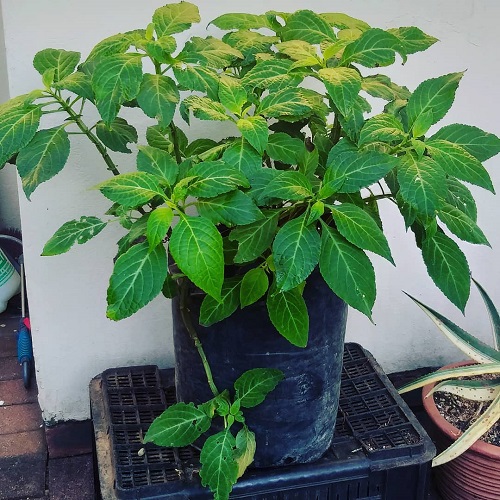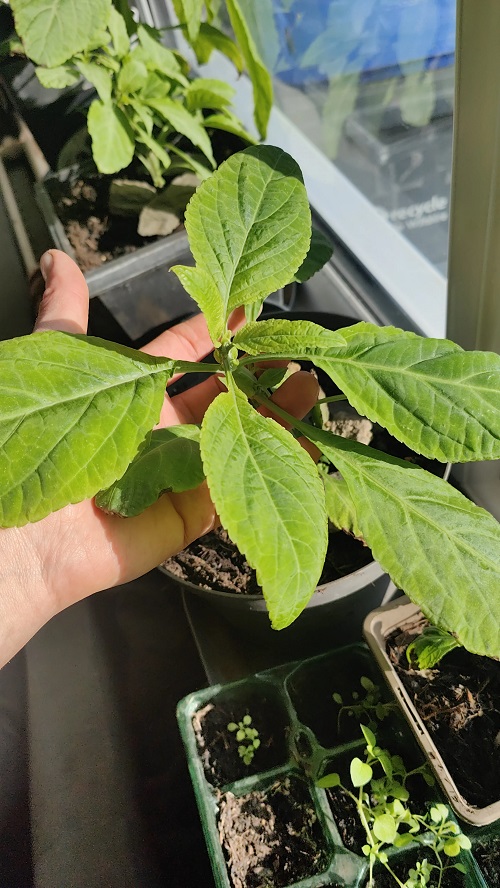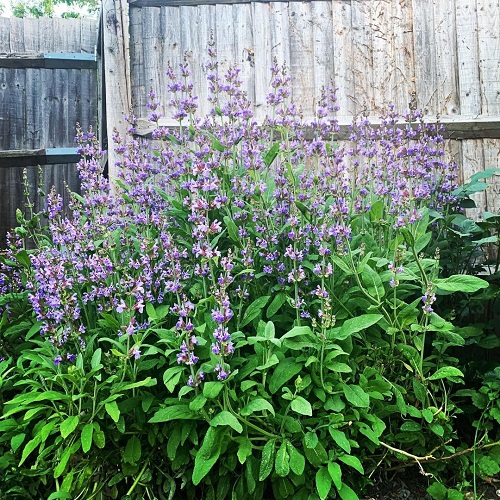Check out our detailed guide on Salvia Divinorum Growing Information and Facts that will help you grow it with all the information!

With our Salvia Divinorum Growing Information and Facts guide, you will be able to grow it easily without any fuss!
USDA Zones: 3–9
Common Names: Sage of the Diviners, Lady Salvia, Magic Mint, Diviner’s Sage, Purple Sticky, Sage of the Seers, Sally D.
Check out Jumping Cholla Cactus Facts and Growing Information here
Salvia Divinorum Plant Information
The Lady Sage, or Sage of the Diviners, is a unique and revered plant native to the cloud forests of Oaxaca, Mexico.
Salvia divinorum boasts large, vibrant green leaves with a velvety texture. It can reach a height of up to three feet and produces small, white flowers when it reaches maturity.
One of the most notable features of Salvia divinorum is its potent psychoactive properties. The plant contains the compound salvinorin A, which is known for inducing intense hallucinogenic experiences when consumed or smoked.
While Salvia divinorum is primarily recognized for its psychoactive effects, it also holds cultural and spiritual significance. The Mazatec indigenous people of Mexico have traditionally used the plant for spiritual rituals and healing purposes.
Note: It’s important to note that the cultivation, sale, and consumption of Salvia divinorum may be regulated or prohibited in various regions, so it’s essential to familiarize oneself with the legal status and potential risks associated with its use.
Learn about Bleeding Heart Flower Meaning and Facts here
Salvia Divinorum Plant Facts

- Salvia divinorum, also known as “Diviner’s Sage,” is a perennial herb belonging to the mint family (Lamiaceae).
- It is native to the cloud forests of the Sierra Mazateca region in Oaxaca, Mexico. Salvia divinorum has been used for centuries by the Mazatec people for spiritual and shamanic purposes.
- The plant has large, green, heart-shaped leaves with a velvety texture. Salvia divinorum can grow up to 4-5 feet (1.2-1.5 meters) in height and has a width of approximately 3-4 feet (0.9-1.2 meters).
- It contains the psychoactive compound known as Salvinorin A, which is considered one of the most potent naturally occurring hallucinogens. Salvinorin A activates kappa-opioid receptors in the brain, leading to altered states of consciousness and vivid hallucinations.
- The effects of the plant are typically intense but short-lived, with the main experience lasting for about 10-20 minutes. It is often consumed by chewing the leaves or by smoking dried leaves or extracts.
- Salvia divinorum is legal in some countries and jurisdictions but is considered a controlled substance or regulated in others due to its psychoactive properties.
- The plant is also being studied for its potential therapeutic uses, including in the treatment of addiction and mood disorders.
Note: Due to the potent effects and potential for misuse, caution should be exercised when using Salvia divinorum, and it should only be consumed in a safe and controlled environment.
Here are Dragon Tail Philodendron Care Tips and Tricks
Salvia Divinorum Growth Requirements

Sunlight
Salvia divinorum thrives in indirect or filtered sunlight. It prefers bright but not direct sunlight, as excessive exposure to direct sunlight can cause leaf burn and stress the plant. Providing it with partial shade or dappled sunlight is ideal.
Soil
This plant requires well-drained soil that retains moisture without becoming waterlogged. A mix of peat moss, perlite, and organic matter such as compost or leaf mold can create a suitable growing medium.
The pH level of the soil should be slightly acidic to neutral, around 6.0 to 7.0.
Here are 9 Signs that Show Your Soil is Bad & You Should Discard It
Water
Salvia divinorum appreciates consistent moisture, but it is crucial not to overwater the plant. It is best to keep the soil slightly moist, allowing the top inch or so to dry out between waterings.
Overwatering can lead to root rot, so it’s important to strike a balance and avoid waterlogging the soil.
Here are Signs of Overwatering & How to Save an Overwatered Plant
Temperature
It prefers a warm and humid climate. It thrives in temperatures ranging from 18°C to 27°C (64°F to 81°F). Extreme heat or cold should be avoided, as it can stress the plant.
If grown in cooler climates, it is advisable to provide protection or bring the plant indoors during colder seasons.
Salvia Divinorum Care

Fertilizer
Salvia divinorum generally benefits from regular feeding with a balanced, water-soluble fertilizer. During the growing season, which is typically spring to summer, applying a diluted liquid fertilizer every two to four weeks can provide the necessary nutrients.
It is important not to over-fertilize, as excessive nutrients can lead to leggy growth or reduced potency.
Here is Dried Banana Peel Powder Fertilizer at Home for Any Plant
Pruning
Pruning Salvia divinorum can help maintain a compact and bushy shape. It is generally recommended to prune the plant in early spring or late winter before new growth appears.
This can involve removing dead or damaged branches and cutting back excessive growth to promote branching and density. Regular pruning can also prevent the plant from becoming lanky or sprawling.
Pests and Diseases
Salvia divinorum is generally resilient against pests and diseases. However, it can still be susceptible to common garden pests such as aphids, spider mites, and whiteflies.
Regularly inspecting the plant for any signs of infestation, such as discolored leaves or webbing, and promptly treating affected areas with organic insecticidal soap or neem oil can help control these pests.
Additionally, providing adequate air circulation and avoiding overwatering can minimize the risk of fungal diseases like powdery mildew.

